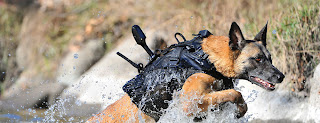Los primeros policía de la unidad K9, de acuerdo con las investigaciones de la Enciclopedia Británica, aparecen a principios del siglo XX en Gante, Bélgica.
Con el tiempo la práctica fue perfeccionando y ampliándose a otros lugares como Hungría, Austria, Alemania o Francia.
El éxito de esta práctica desembocó en una ley alemana enamorada del potencial de la seguridad animal: "En Alemania en 1911, había más cuatrocientas estaciones de policía previstas con instalaciones para entrenar especialmente a los perros."
Los ingleses también comenzaron a considerar la viabilidad de emplear a perros como policías. Los animales empezaron a trabajar en calidad de ayudantes, acompañando a patrullar a los policías de aquella época.
Los perros en Inglaterra contaban con muy buenos antecedentes en labores de búsqueda y rastreo, en el siglo XIX los sabuesos fueron empleados en la ardua búsqueda de Jack El Destripador.
El éxito con los perros continuó con la Fuerza Policial Continental en los años 20. Diez años después, en 1930, despertaron el interés del Ministerio del Interior de Gran Bretaña: "Dos perros labradores, especialmente entrenados, fueron introducidos oficialmente en la Policía Metropolitana en 1938, y se asentaron en el sur de Londres con la idea de acompañar a la policía en sus golpes."
Durante la Segunda Guerra Mundial, el empleo de los perros en funciones militares fue crucial en Estados Unidos. El continente Americano se esforzó para reclutar y adiestrar al mayor número de perros posible.
Con la guerra nace el término K9, entre 1940 y 1950, eran un uso informal que se empleaba tanto en el ámbito policial como militar. El término K9 es un homófono de la palabra canino.
El pastor alemán es considerada como una de las razas élite en su deber de proteger la seguridad de los ciudadanos.
Su buena reputación proviene, paradójicamente, de su labor en los campos concentración durante la Segunda Guerra Mundial.
En la actualidad, aunque existen razas muy competentes, los pastores alemanes siguen disfrutando de una muy buena reputación, especialmente por su dentadura: Cuando un perro alemán ataca no se limita a intimidar. Cuando muerde los incisivos superiores e inferiores se conectan como tijeras y los dientes caninos grandes extraen pedazos de carne. Las heridas se infectan gravemente, y las cicatrices suelen ser permanentes, afirma el K9 Global Training Academy un centro de formación de Texas para perros potenciales agentes.
The first police K9 unit, according to the investigations of the Encyclopedia Britannica, appear in the early twentieth century in Ghent, Belgium.
Over time the practice was refined and expanded to other places like Hungary, Austria, Germany or France.
The success of this practice led to a German law potential love animal safety: "In Germany in 1911, there were over four hundred police stations provided with training facilities especially dogs."
The British also began to consider the feasibility of employing as police dogs. The animals began to work as aides, accompanying the police patrol at that time.
Dogs in England had very good background in search and tracking tasks in the nineteenth century the hounds were employed in the arduous search for Jack the Ripper.
The success continued with dogs Continental Police Force in the 20s. Ten years later, in 1930, aroused the interest of the Ministry of Interior of Great Britain: "Two Labrador retrievers, specially trained, were officially introduced in the Metropolitan Police in 1938, and settled in South London with the idea of accompanying police on his punches. "
During World War II, the use of dogs in military roles was crucial in the United States. The American continent struggled to recruit and train as many dogs as possible.
With war comes the term K9, between 1940 and 1950, was an informal usage is used both in the police and military. The term K9 is a homophone of the word canine.
The German Shepherd is considered one of the elite races in its duty to protect the safety of citizens.
His good reputation comes, paradoxically, from his work in concentration camps during the Second World War.
At present, although there are very competent breeds, German Shepherds are enjoying a very good reputation, especially for its teeth: When a German dog attacks not limited to intimidate. When bites the upper and lower incisors connect like scissors and the large canine teeth extracted pieces of meat. Severely infected wounds, and scars are usually permanent, says the K9 Global Training Academy training center for dogs Texas potential agents.



No hay comentarios:
Publicar un comentario